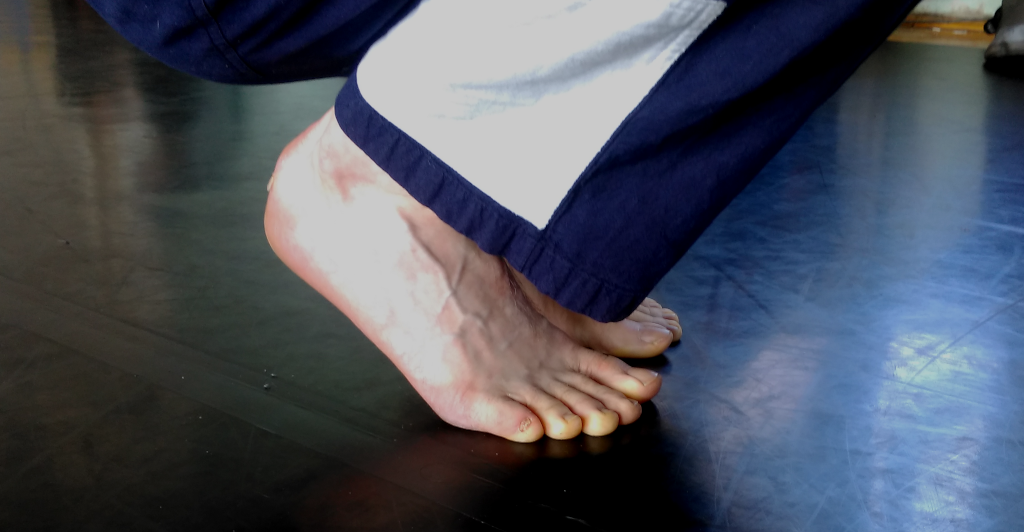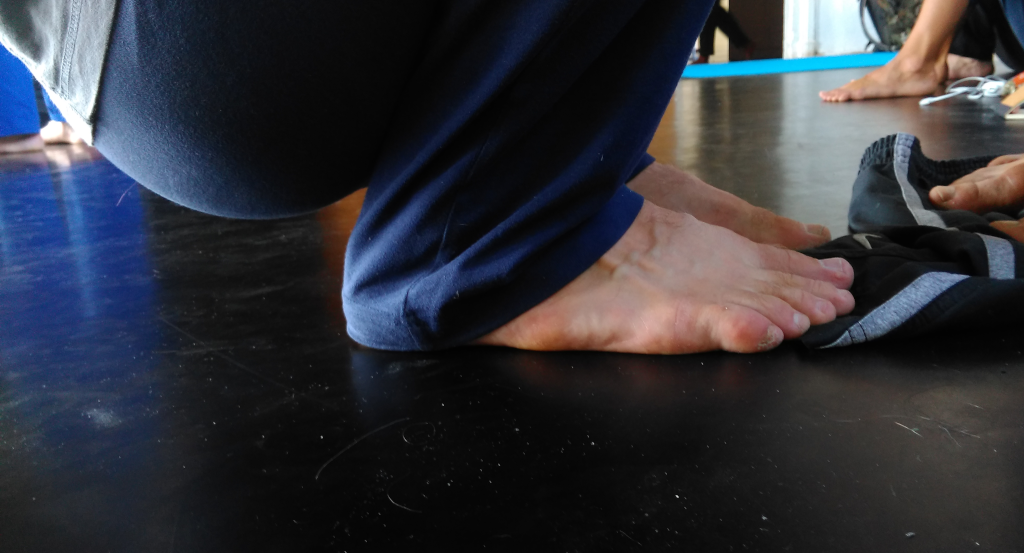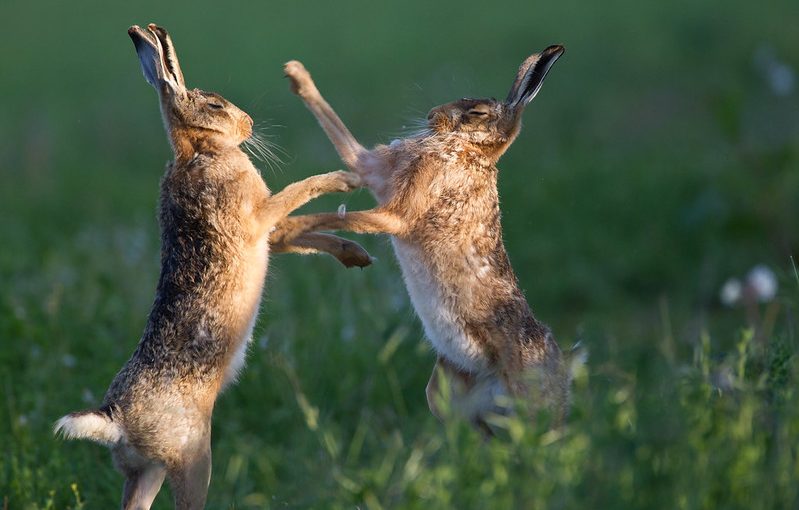I attended a class on 10 June lead by Justin Philpot with Soledad at CI Goldsmiths, University of London. Two exercises which he presented, left me questioning how we teach and what the exercises taught us. Here, I discuss and analyse them.
Justin demonstrated the two exercises, both of which involved working with a partner ie a duet. I don’t know if they had a name so I gave them a name. They might have originated in Aikido – certainly I can imagine the skills would be useful in that martial art. Here’s the two exercises which were presented in this order. Both are performed on our feet.
I draw my impression of them, presented below.

The top sketch is exercise 1, and the bottom sketch is exercise 2.
Exercise 1: ‘Hare Boxing’
You crouch down with your backside against your heals ie a squat where your legs are folded underneath you, maintaining an upright position. You’re on tip-toes or certainly the front of your foot. Your partner does the same – facing you. While it’s possible to maintain this stance, it’s inherently unstable but you have little distance to fall to the ground. But fundamentally, we’re on our feet and our hands/arms are not!
You physically interact with your partner, moving, using your arms, your shoulders and body to contact with the other person. It’s as if you’re sparing with each other although since it’s not a competitive practice, there is no winner and no way to win.
There’s no boxing! We’re not hitting each other! The analogy with hares is simply that when they stand on their hind legs then they are unstable – rather like the duet partners. You can push with your hands and arms, move closer and apart from each other. You could grip and pull your partner, push them or indeed contra-balance with them.
When explaining this exercise, Justin demonstrates it – dances it – with a partner. A dance teacher who is present in the audience/class, asks for a verbal commentary saying “Tell me what you’re doing. Give me verbs!”. I could sense some frustration from them. Maybe they’d have taught this differently?
I reflected that dance is a non-verbal dialogue. So dancing the answer was a completely valid response from Justin to the query and the request for ‘verbs’. Furthermore, we may ask students to investigate and explore dance without specifically teaching a technique. Ideally, we want the students to feedback their findings to the group as individual duets may have different experiences.
It’s a research
When I tried this exercise with my partner, they looked around to see what other participants were doing – perhaps they were confused? Surely though, what matters is that we research the movement possibilities rather than we ‘get it right’. It’s easy to overlook the most important take-away from this exercise: squatting down and interacting like this is the practice – or a part of it – which we call contact improvisation. You can do contact improvisation like this – if you want! You can be confused and searching – that’s okay too!
Another obvious element of this exercise, is that being on the front of the foot makes you less stable than when you have the whole of your foot on the ground. Also, when both feet are aligned then it’s less stable than when one is behind the other. Something which is apparent in succeeding exercise.
Interestingly, if you push your partner when squatted, with you hand/arm then you push yourself out of balance. We might say that when we push, we expand the space. It’s the space of our kinosphere which expands. Arguably, the distance to your partner increases, and we can easily push ourselves out of balance.
I found it easier to move my pelvis to my partner and form a bridge as our bodies were in contact. When we both lean-in then it becomes more stable; there’s more structure. Bridges keep the banks in place as well as providing a connection between two places!
Exercise 2: Reach for the Earth!
The second exercise, I called ‘Reach for the Earth’. Perhaps because, the previous weekend, I’d been to a workshop with Nita Little – one of the pioneers of contact improvisation. She expresses this idea of grounding as touching or reaching for the earth. I could almost hear her saying it!
Stand on your feet, facing your partner. Put one hand on your partner’s upper chest, just below your collar bone. Your partner simply stands and accepts the flat of your hand on their upper chest – their sternum; and their hands are by their sides. Now, maintaining your stance and mostly avoiding stepping, press your hand into your partner or remove the pressure and see how it affects your stance; how it feels; and if you over balance or fall forward.
I find that I can maintain my stance by softening at the knees and waist. Allowing them to flex and not holding them. I also notice how my weight is on my heels and not the front of my feet. I recall that I am connecting my upper body with my feet, and I try to feel this connection – changing my posture, my leaning in-and-out in order to absorb any pressing or expansion from my partner. Of course, it’s easier if I have one foot behind the other than in a line. I also find myself recalling my Qi-gong practice which is also a standing practice. Mostly, I feel that this is a practice in grounding and stability. It certainly shows the important of your heel and the whole foot being in contact with the ground. Hence, you are reaching for the earth – from your centre to your feet while also connecting the upper body too. If the previous exercise was one in instability; this one is a lesson in stability.
Afterthoughts
Discussing this article with two experienced dancers in contact improvisation (Manuel and Yin from Berlin) then we make these additional observations of the above two exercises:
Both exercises: Turning the upper body in either two exercises allows for deflection of moment to your partner which is consistent with the idea of not blocking but allowing the movement/energy to flow.
Exercise 1: The dance partners are squatting. However, this doesn’t mean that everyone will be on their tip-toes – like me! Some people have more flexibility in their ankle and they can remain flat-footed (all sole of foot in contact with the floor) even when squatted – Manwell for example – see photo below. I was told that the teaching in authentic movement practice may improve ankle flexibility. But having all the foot on the floor doesn’t increase stability as the body tends to hang over the centre of balance – to one side. This also hinders movement of the body to regain stability if pushed over.


Exercise 2: This exercise is reminiscent of one from Tai Chi called tuishou (meaning pushing hands). But in the class exercise, the hand of one partner is on the chest of the other dancer rather than – as in ‘pushing hands’ where both partners are having contact through their arms/hands and pushing or giving weight through them. But both the class exercise and ‘push hands’ are standing exercises. Thank-you to Yin for this clarification. Example of ‘push hands’ below (YouTube).
Further reading
Book – ‘Dancing Deeper Still: The Practice of Contact Improvisation’ by Martin Keogh.
See Martin’s website and publication
Notes
Featured image above Brown Hares, Lepus europaeus. Credit: © Natural England/Allan Drewitt, 2014. Used under Creative Commons license: Attribution-NonCommercial-NoDerivs 2.0 Generic (CC BY-NC-ND 2.0). Source: https://www.flickr.com/photos/naturalengland/14590700893/in/photolist-oeka3v-2i7KyiC-8CATg3-6gZmYF-8tFGim-87BwM1-2ocUw5v-24nFmeq-8tFG7o-WYhCkF-bDPgoe-9odUMR-9d4XBm-2DUmiW-FYXjCL-KSwTBV-51tap-X7uW2-51ta9-sAzHW9-mCwHF-oe3Rxs-bifHmg-bjY3h4-MoCxH-2DUmhL-2kRL4Kj-7ejRQi-MG3T5-2DUmif-87DwNP-nQVj1c-nkdYtt-48VzD-9zCMHs-a4r8Z7-2DUmj9-2ioxyK7-55tsrS-22Y3QwD-D7eAjh-q46Po-59G1xe-wRgy4M-2o6wnX7-7Rt2AG-vzmTeb-24RDuCi-7cSSqq-JUkn2k
